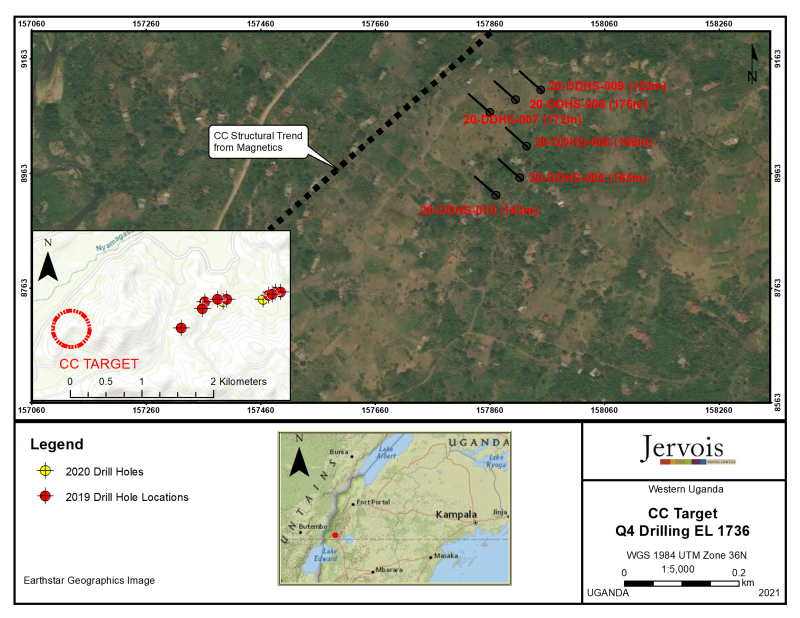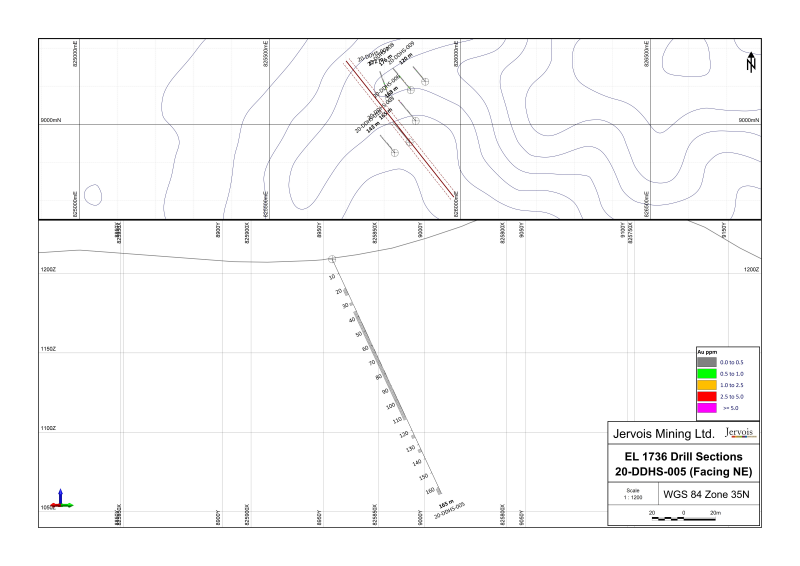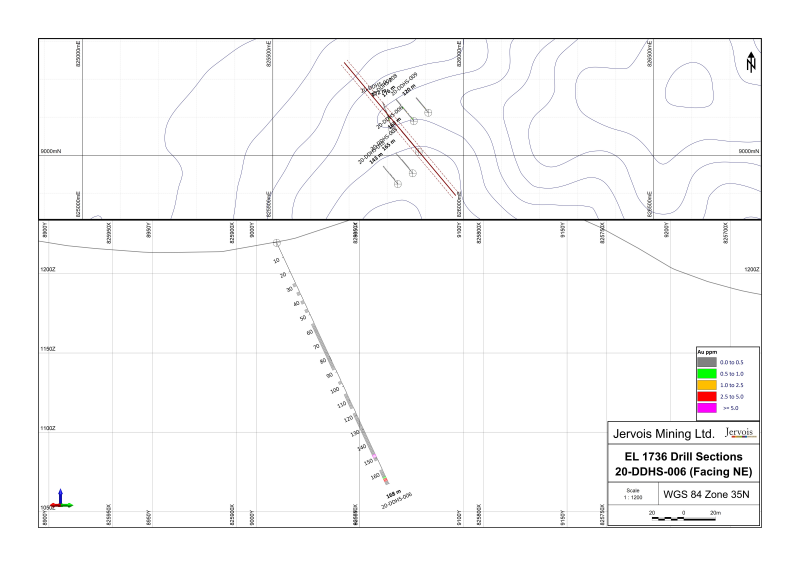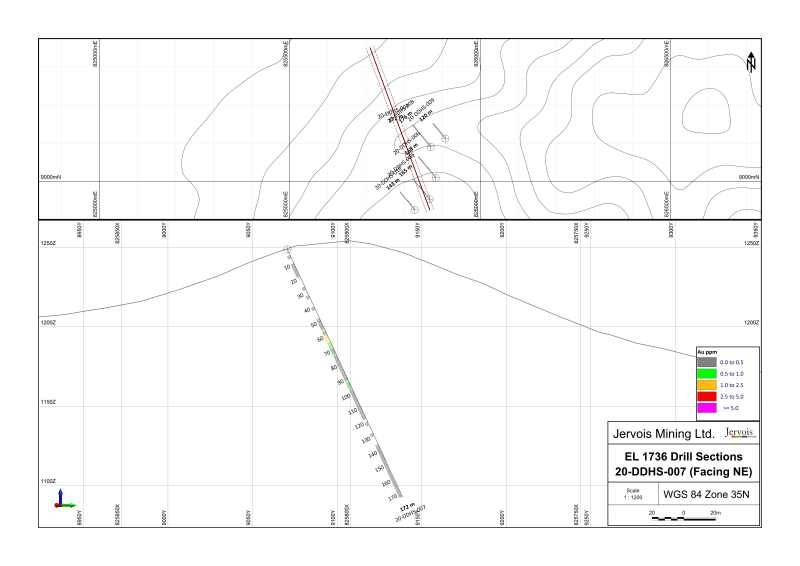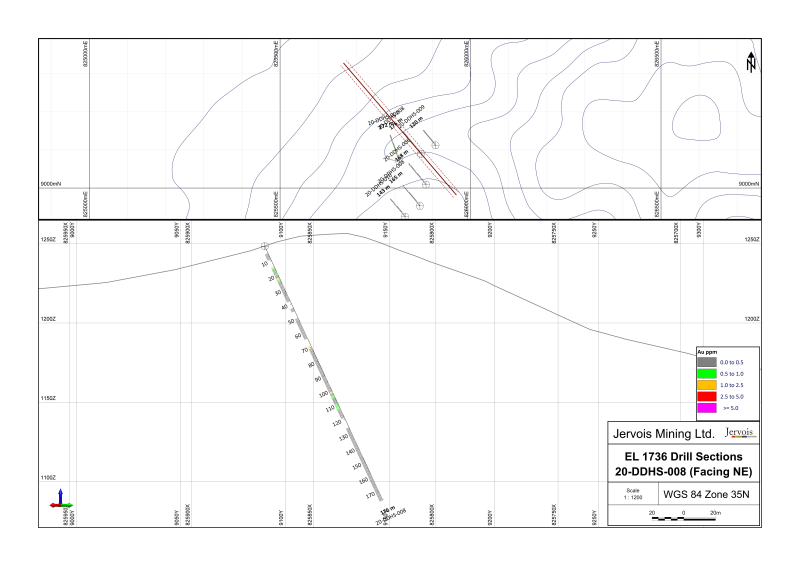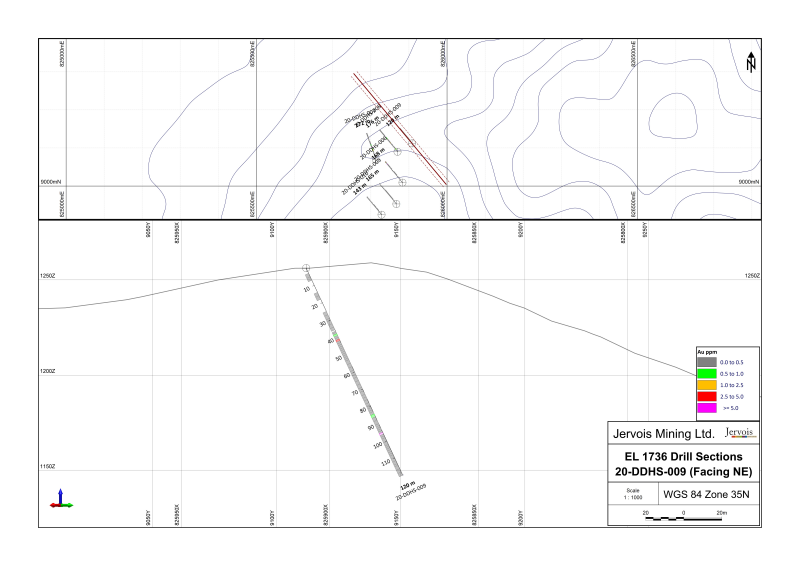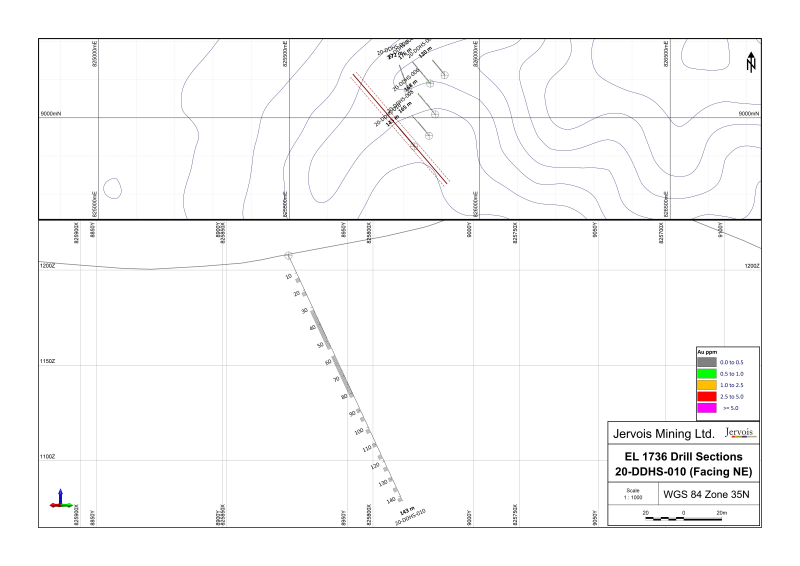Archive
Jervois Mining provides Ugandan Exploration Update
 | |||||||||
 |  | ||||||||
HIGHLIGHTS
-
- Six diamond drill holes (totaling 943 metres) completed at Kilembe to test the high-grade Cu-Au anomalies (CC Target) during Q4 2020. All results have now been received. Result highlights include:
-
-
-
- Hole 20DDHS006
-
-
-
-
- 2.0m @ 6.0 grams per tonne gold (“g/t Au”) from 147.4m
-
- Hole 20DDHS007
-
- 24.8m @ 0.9 g/t Au from 53.7m
Including 1.05m @ 6.4 g/t Au; from 77.45m
-
- Hole 20DDHS008
-
- Hole 20DDHS009
-
- 10.0m @ 0.5 g/t Au from 38.0m
Including 1.0m @ 2.9 g/t Au; from 41.0m
-
- 1.0m @ 5.0 g/t Au; from 95.0m
-
- Drilling extends known mineralization at surface to over 6.0km strike length, with only 1.8km tested.
- Latest results continue to expand the prospective areas and improve understanding of mineralization at Ugandan properties.
- All activity in Uganda has been suspended
- Jervois maintain an executive presence in Uganda and continue negotiations with government regarding the Kilembe copper-cobalt mine and Kasese Cobalt refinery.
TheNewswire – January 26th, 2021 - Jervois Mining Limited (the “Company” or “Jervois”) (ASX:JRV) (TSXV:JRV) (OTC:JRVMF) is providing an update on drill programme at its Kilembe area properties in central and western Uganda, following receipt of assays from Q4 2020 exploration.
Drilling at the Kilembe Area Properties targeted surficial Au-Cu mineralization detected through earlier geochemical programmes. In total, 1,905 metres of diamond drilling was completed in 17 holes drilled at the Kilembe Area Properties in 2019 and 10 holes in 2020, totaling 1,409m. The drill hole locations for drilling at the CC Target in Q4 2020 are shown on Figure 1 and the drilling result highlights are in Table 1.
Figure 1: Phase 2 – Kilembe Area CC Drilling
These results continue to expand the prospective areas and improve understanding of mineralization at Ugandan properties.
Table 1: Kilembe Area (CC Target) Drilling Highlights, Au > 0.3 g/t; Cu > 0.1%*
|
Hole ID |
End Of Hole (metres) |
Location UTM WGS 1984 |
Dip |
Azimuth |
Depth From (metres) |
Depth To (metres) |
Intercept (metres) |
Au g/t; Ag g/t; Cu %* |
|
20DDHS005 |
165 |
825867_X/8953_Y |
-65 |
320 |
65.7 |
67.7 |
2.0 |
0.13% Cu |
|
20DDHS006 |
168 |
825883_X/9009_Y |
-65 |
320 |
141.75 |
146.4 |
4.65 |
0.2% Cu |
|
147.4 |
149.4 |
2.0 |
6.0 g/t Au |
|||||
|
158.0 |
160.0 |
2.0 |
0.4 g/t Au |
|||||
|
162.0 |
168.0 |
6.0 |
1.2 g/t Au |
|||||
|
Including |
163.0 |
166.0 |
4.0 |
2.0 g/t Au |
||||
|
164.0 |
167.0 |
3.0 |
0.19%Cu |
|||||
|
20DDHS007 |
172 |
825813_X/9070_Y |
-65 |
340 |
53.7 |
78.5 |
24.8 |
0.9 g/t Au |
|
Including |
59.0 |
65.0 |
6.0 |
1.4 g/t Au |
||||
|
Including |
77.45 |
78.5 |
1.05 |
6.4 g/t Au |
||||
|
91.0 |
99.0 |
8.0 |
0.5 g/t Au |
|||||
|
20DDHS008 |
176 |
825870_X/9090_Y |
-65 |
320 |
14.0 |
24.4 |
10.4 |
0.6 g/t Au |
|
Including |
19.0 |
21.0 |
2.0 |
0.11% Cu |
||||
|
Including |
21.8 |
24.4 |
2.6 |
1.2 g/t Au |
||||
|
69.15 |
70.8 |
1.65 |
1.6 g/t Au |
|||||
|
101.0 |
105.0 |
4.0 |
0.8 g/t Au |
|||||
|
107.0 |
113.0 |
6.0 |
0.6 g/t Au |
|||||
|
20DDHS009 |
120 |
825908_X/9112_Y |
-65 |
320 |
38.0 |
48.0 |
10.0 |
0.5 g/t Au |
|
Including |
41.0 |
42.0 |
1.0 |
2.9 g/t Au |
||||
|
50.0 |
53.0 |
3.0 |
0.4 g/t Au |
|||||
|
80.7 |
91.0 |
10.3 |
0.3 g/t Au |
|||||
|
95.0 |
96.0 |
1.0 |
5.0 g/t Au |
|||||
|
20DDHS010 |
143 |
825828_X/8925_Y |
-65 |
320 |
62.5 |
63.0 |
0.5 |
0.2% Cu |
|
69.8 |
70.8 |
1.0 |
0.13% Cu |
* As this is an initial drilling programme true widths are currently unknown.
These latest drilling results provide further encouragement on Jervois’ Ugandan exploration properties. The highly anomalous results achieved to date continue to expand the prospective areas and improve the understanding of the mineralization present.
Drill site reclamation and rehabilitation was immediately carried out in accordance with the terms of the ESIA certificate from NEMA and international good practice.
Throughout the recent drilling program, Jervois’ stringent Covid-19 management measures enabled ongoing and positive albeit modified engagement with communities within the drill program area and local and central government. Throughout the duration of the program, no cases of covid-19 were obtained throughout regular PCR testing of Jervois personnel, contractors and local service providers and the situation provided an opportunity to build local understanding of both the project and measures to prevent the spread of the virus.
All exploration activities in Uganda have been suspended due to a combination of ongoing Covid-19 risks, political and regulatory developments in-country and results to date outside the Kilembe Area Properties which do not meet mineralization model expectations for copper-cobalt ore deposits. Jervois is initiating a partnering process for its Ugandan exploration portfolio and the current book value (A$20.5 million) will be subject to careful impairment review as part of the December 2020 annual account preparation.
Jervois continues to maintain a footprint and executive presence in Uganda, as it continues to negotiate with government regarding its interests in the Kilembe copper-cobalt mine and Kasese Cobalt refinery.
All rock and soil samples are sent to ALS Chemex South Africa (Pty) Ltd, an independent and fully accredited laboratory in South Africa for analysis for gold multi-element Induction Coupled Plasma Spectroscopy. Jervois also has a regimented Quality Assurance, Quality Control program where at least 10% duplicates and blanks are inserted into each sample shipment.
On behalf of Jervois Mining Limited,
Bryce Crocker, CEO.
For further information, please contact:
|
Investors and analysts: Bryce Crocker Chief Executive Officer Jervois Mining Limited |
Media: Nathan Ryan NWR Communications nathan.ryan@nwrcommunications.com.au Mob: +61 420 582 887 |
Competent Person’s Statement
The information in this release that relates to Mineral Exploration is based on information compiled by David Selfe who is full time employee of the company and a Fellow of the Australasian Institute of Mining and Metallurgy and Dean Besserer, P.Geol. who is the GM Exploration for the company and a member of The Association of Professional Engineers and Geoscientists of Alberta. Both David Selfe and Dean Besserer have sufficient experience which is relevant to the style of mineralization and type of deposit under consideration and to the activity which they are undertaking to qualify as a Competent Person as defined in the 2012 Edition of the ‘Australasian Code for Reporting of Exploration Results, Mineral Resources and Ore Reserves’. David Selfe and Dean Besserer consent to the inclusion in the release of the matters based on their information in the form and context in which it appears.
Disclosure required for TSX-V Regulations
Qualified Person’s Statement
The technical content of this news release has been reviewed and approved by Dean Besserer, P.Geol., the GM Exploration for the Company and a Qualified Person as defined by National Instrument 43-101.
Neither TSX Venture Exchange nor its Regulation Services Provider (as that term is defined in policies of the TSX Venture Exchange) accepts responsibility for the adequacy or accuracy of this release.
Forward-Looking Statements
This news release may contain certain “Forward-Looking Statements” within the meaning of the United States Private Securities Litigation Reform Act of 1995 and applicable Canadian securities laws. When used in this news release, the words “anticipate”, “believe”, “estimate”, “expect”, “target, “plan”, “forecast”, “may”, “schedule” and other similar words or expressions identify forward-looking statements or information. These forward-looking statements or information may relate to exploration work to be undertaken in Uganda, the reliability of third-party information, and certain other factors or information. Such statements represent the Company’s current views with respect to future events and are necessarily based upon a number of assumptions and estimates that, while considered reasonable by the Company, are inherently subject to significant business, economic, competitive, political and social risks, contingencies and uncertainties. Many factors, both known and unknown, could cause results, performance or achievements to be materially different from the results, performance or achievements that are or may be expressed or implied by such forward-looking statements. The Company does not intend, and does not assume any obligation, to update these forward-looking statements or information to reflect changes in assumptions or changes in circumstances or any other events affections such statements and information other than as required by applicable laws, rules and regulations.
Appendix 1 – Drillhole Cross Sections
JORC Code, 2012 Edition – Table 1
Section 1 Sampling Techniques and Data
|
Criteria |
JORC Code explanation |
Commentary |
|
Sampling techniques |
|
Sampling to date includes 5,138 diamond drill samples (from 59 diamond core drill holes); 23,142 soil samples; 3,625 rock samples, 26 Heavy Mineral Concentrates; 25 stream silt samples; 1,258 trench samples (rock); and, 379 trench samples (soil). All drill core was generally sampled on 1m intervals, contingent on geology and core recovery: Core was collected directly from the core barrel into core boxes, and Core samples were split in half, with the top half of the core analysed and other half retained as reference core in the tray. Core trays were clearly labelled with the hole number, tray number and metre intervals marked. Bottom-of-hole orientation line was marked prior to geological logging and sampling. Soil samples (B Horizon) are collected using a pick and spade to dig small pits which are filled back in after the sample is collected. The samples are collected in 4x6’ kraft bags and closed/sealed with a zip tie. All sample information is recorded on hand-held devices utilizing the Fulcrum App. ALS Sample tag books are utilized for sample identifiers which are scanned and/or entered manually. The sample identifier is written on the bag and a tag is placed in the bag. Sample and site photos are recorded at every site. Devices are downloaded daily are all information is stored to the cloud. Rock samples (typically grab samples) are collected using a rock hammer. The samples are selective and are not necessarily indicative of mineralization. The samples are collected in 12x20 plastic ore bags and closed/sealed with a zip tie. All sample information is recorded on hand-held devices utilizing the Fulcrum App. ALS Sample tag books are utilized for sample identifiers which are scanned and/or entered manually. The sample identifier is written on the bag and a tag is placed in the bag. Sample and site photos are recorded at every site. Devices are downloaded daily are all information is stored to the cloud. Samples were cut along the orientation line before being correctly placed back into the tray. The half-core was sampled, ensuring that the same side is consistently sampled, and placed into sample bags labelled with the assigned sample number. Orientation lines are determined using a Reflex ACTIII orientation tool. Downhole measurements are recorded using a Reflex EZ-Gyro Kit at multiple intervals down each hole and always at the end of every hole. Field sampling followed Jervois protocols including industry standard quality control procedures. All samples were sent to ALS Chemex South Africa (Pty) Ltd., an independent and fully accredited laboratory in South Africa (“ALS”) for analysis for gold multi-element Induction Coupled Plasma Spectroscopy (“ICP”). Jervois also has a regimented Quality Assurance, Quality Control (“QA/QC”) programme where at least 10% duplicates and blanks are inserted into each sample shipment. Sample representativity is ensured by: Diamond Core: For all drilling core was halved for sub‐sampling with a diamond saw. Sample intervals range from 0.1 to 2 m in length, with majority of samples assayed over 1 m intervals. Rock grab samples are by their nature selective and are not necessarily indicative of the general geology of the property. Handheld XRF instruments were used to spot check rock grab and/or drill core for mineralization, however those results were not relied on. All sample results reported on are from ALS Chemex South Africa (Pty) Ltd. Some Drill holes were lined with PVC piping and in most holes, downhole Electromagnetics were completed after drilling was complete. All of the drilling was diamond drill core (HQ/NQ). Typically, drill core was sampled on nominal 1m half core samples. All sample analyses were completed at ALS Chemex South Africa (Pty) Ltd. and/or ALS Chemex Vancouver, Canada. ALS is a global independent laboratory which is ISO accredited. Samples are received at the laboratory: Bar codes are scanned and logged; samples are weighed and dried; samples are crushed and pulverized (-180 mesh soils; -75microns rocks) then riffle split; all samples are analyzed for 35 elements using ICP-AES and gold using 30 gram fire assay for soils and 50 gram Fire assay for rocks, both with an AA finish. Any samples with over-limits specific to base metals or gold are re-analyzed. Samples with visible gold were check analysed by using a screen fire-assay method. |
|
Drilling techniques |
|
HQ casing/coring within saprolite yet the majority of the core was NQ Holes were generally angled from 45 to 90 degrees at varying azimuths. Reflex Orientation tool was used for structural orientations, and depths varied from 8.85m to 418.8m. |
|
Drill sample recovery |
|
All holes are teched and all intervals are measured for recovery and RQD’s are calculated. Recovery % recorded in the geotechnical records as equivalent to the length of core recovered, as a percentage of the drill run. Excellent recoveries were obtained from Diamond drilling. There is no bias noted between sample recovery and grade. Excellent recoveries were obtained from Diamond drilling. |
|
Logging |
|
Diamond drilling: Drill core is photographed and logged prior to sampling; Core has been geologically and geotechnically logged to a level of detail appropriate to support mineral resource estimation and mining studies. Logging has been conducted both qualitatively and quantitatively; full description of lithologies, alteration and comments are noted, as well as percentage estimates on veining and sulphides. In total, 10,078m of diamond drill core have been completed. All drill holes are logged in their entirety. |
|
Sub-sampling techniques and sample preparation |
For all sample types, the nature, quality and appropriateness of the sample preparation technique.
|
Core was half-cut lengthwise using a diamond saw along the orientation line. The half-core was sampled, generally on metre intervals. Samples are received at the laboratory: Bar codes are scanned and logged; samples are weighed and dried; samples are crushed and pulverized (-75microns rocks) then riffle split; all samples are analyzed for 35 elements using ICP-AES and gold using 50 gram Fire assay with an AA finish. Any samples with over-limits specific to base metals or gold are re-analyzed. For core sampling the same side is consistently sampled, half-core with the bottom of hole line is retained in the tray. The assay sub- sample is placed into sample bags labelled with the assigned sample number. One in 20 samples is duplicated where the core is quartered and a quarter cut sample is analysed as a duplicate. The remaining quarter samples is retained in the tray. Sample sizes of 2-3 kg are appropriate for the grain size of material. The sample preparation technique and sample sizes are considered appropriate to the material being sampled. |
|
Quality of assay data and laboratory tests |
|
The ICP-AES and Fire Assay (50 gram) are considered total and are high quality. Jervois has a regimented Quality Control protocol which has consisted of systematic submission of blanks and duplicates in addition to those conducted at the laboratory. Precision levels for all blank and duplicate samples fell within acceptable ranges. |
|
Verification of sampling and assaying |
|
Since no economic intersections have been reported, independent verification has not yet been necessary. No holes have been twinned. Data is collected using a customized version of the Fulcrum app. The data is backed up systematically on and off site as well as on the cloud. As well, data is recorded using a master Microsoft Office Excel spreadsheet and all location and assay data are compiled in a Microsoft Office Access database. All data below detection limit have been entered as zero. Samples received damaged at the laboratory, or with insufficient sample weight for analysis had the interval or location left blank, but in general were re-sampled and/or re-collected (specific to soils and rock grab samples). |
|
Location of data points |
|
All collars were surveyed by trained surveyors using a Leica Differential GPS. Down-hole surveys were routinely carried out on all holes using a Reflex EZ-Gyro Kit. Trenches and surface samples were recorded using handheld GPS. All datum is collected and recorded in UTM WGS 1984. The 3D location of the individual samples is considered to be adequately established, consistent with accepted industry standards. Locations are shown on maps provided. Cross sections and a complete table of results are only reported when target mineralization was intercepted with the consistency of width and grade necessary to support a potentially economic resource |
|
Data spacing and distribution |
Whether the data spacing and distribution is sufficient to establish the degree of geological and grade continuity appropriate for the Mineral Resource and Ore Reserve estimation procedure(s) and classifications applied.
|
To date, due to the exploratory nature of the drilling, the spacing is highly variable. Similarly, rock grab sample spacing is random. Soil samples are collected in grids designed at varying spacings from >350m to 25m spaced samples.
Samples intervals are reported as weighted average grade. |
|
Orientation of data in relation to geological structure |
|
Drilling sections are orientated perpendicular to the strike of the host rocks. Drill holes were inclined between 45° and 90° to optimize intercepts of mineralisation with respect to thickness and distribution. Drilling with angled and vertical holes in most instances provides a representative sample across the stratigraphy. |
|
Sample security |
|
All individual samples are bagged and sealed with a zip tie. Then individual samples are bagged in poly woven sacks and sealed with coded security seals. The laboratory reports all the security seals numbers to Jervois and any problems with the samples. To date, no sample shipments have had reported problems and/or a breach in security. |
|
Audits or reviews |
|
Jervois protocols consist of a regimented internal QA/QC which match or exceed global industry standards. Thus far, due to the exploratory nature of the programme, no audits or external reviews have been conducted. |
